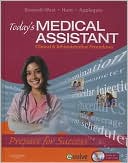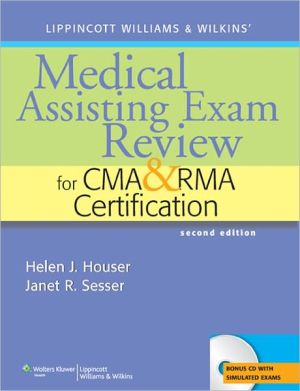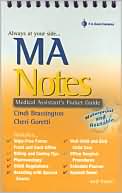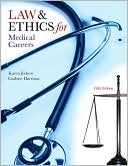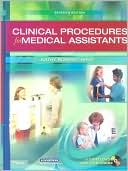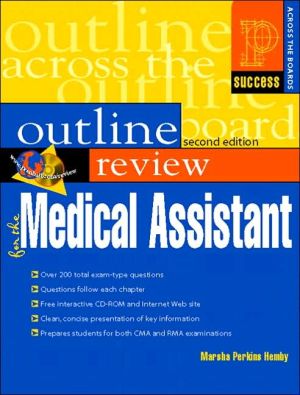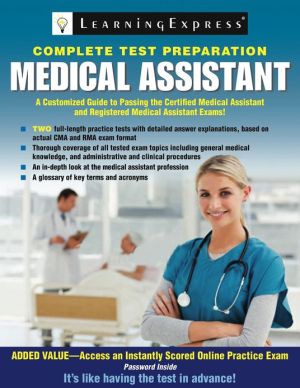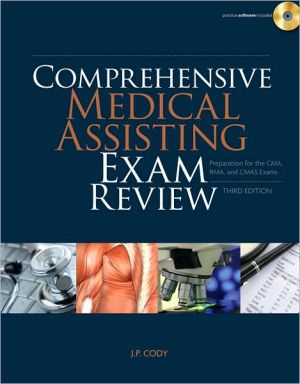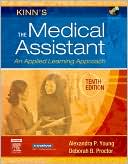Today's Medical Assistant: Clinical & Administrative Procedures
Search in google:
For the first time – all in one volume – here’s everything you need to prepare for a successful career as a medical assistant! Today’s Medical Assistant: Clinical & Administrative Procedures is a hands-on, comprehensive guide to all of the concepts and skills you need for success in today’s busy medical office: medical knowledge, clinical skills, and administrative details. No other medical assisting text provides everything you need in such a practical, accessible package! Bringing together the clinical know-how of Kathy Bonewit-West, the administrative expertise of Sue Hunt, and the anatomy and physiology knowledge of Edith Applegate, this unique text offers a single-volume, manageable approach to both clinical and administrative procedures, as well as an essential understanding of anatomy and physiology. It provides a solid foundation for success in today’s fast-paced medical office, covering all the concepts and skills needed for modern medical assisting and their application to real-life situations.Streaming video presentations of 89 procedures on four companion DVD-ROMs clarify procedures from the text and reinforce your understanding.Two companion CD-ROMs offer animations, games, exercises, and other helpful activities designed to help you assess your content knowledge, improve your critical thinking skills, and make learning more interesting and effective. Interactive A & P Review exercises on the CD-ROM (Body Spectrum and ArchieMD animations with exercises) help you master challenging anatomy and physiology content. Evolve offers online access to additional exercises, charting/documentation examples, and externship evaluation tools.More than 120 procedures are presented in a clear, step-by-step format in the text, including underlying principles and illustrations depicting the technique. Procedures also include Charting Examples to help you understand the process for charting your own procedures. Includes coverage of anatomy and physiology, plus up-to-date content on the medical record (including HIPAA, electronic medical records [EMR], and advanced directives), documentation (including billing and coding), medical office terminology, medical asepsis, vital signs, pediatrics, colonoscopy, IV therapy, CLIA Waived Tests, and much more. What Would You Do?/What Would You Not Do? challenges you to analyze and respond to real-life applications of case studies. Apply your Knowledge questions at the end of each chapter help you assess your knowledge of the material you’ve just covered. Prepare for Certification sections at the end of each chapter help you master important elements covered in medical assisting certification examinations. Putting It All into Practice boxes and Memories from Externship boxes introduce realistic medical assistants so that you can witness real-life medical situations. Patient Teaching boxes emphasize this important aspect of a medical assistant’s daily job. An appendix of common Spanish-English phrases helps you effectively communicate with Spanish-speaking patients. An appendix of helpful websites gives you valuable information on professional organizations, accrediting agencies, and agencies that provide CPR certification.
Section 1: INTRODUCTION TO MEDICAL ASSISTING1. The Health Care System 2. The Professional Medical Assistant3. Ethics and Law for the Medical Office4. Interacting with PatientsSection 2: ANATOMY AND PHYSIOLOGY COMPONENT5. Introduction to Anatomy and Physiology6. Integumentary System7. Skeletal System8. Muscular System9. Nervous System10. The Senses11. Endocrine System12. Circulatory System13. Respiratory System14. Digestive System15. Urinary System16. Reproductive SystemSection 3: CLINICAL COMPONENT17. Medical Asepsis and the OSHA Standard18. Sterilization and Disinfection19. Vital Signs20. The Physical Examination21. Eye and Ear Assessment and Procedures22. Physical Agents to Promote Tissue Healing23. The Gynecologic Examination and Prenatal Care24. The Pediatric Examination25. Minor Office Surgery26. Administration of Medication and Intravenous Therapy27. Cardiopulmonary Procedures28. Specialty Examinations and Procedures: Colon ProceduresMale Reproductive HealthRadiology and Diagnostic Imaging29. Introduction to the Clinical Laboratory30. Urinalysis31. Phlebotomy32. Hematology33. Blood Chemistry and Serology34. Medical Microbiology35. Emergency Medical ProceduresSection 4: ADMINISTRATIVE COMPONENT36. The Medical Record37. Patient Reception 38. Medical Office Computerization 39. Telephone Techniques40. Scheduling Appointments41. Medical Records Management42. Written Communications43. Mail44. Managing Practice Finances45. Medical Coding46. Medical Insurance47. Billing and Collections48. The Medical Assistant as Office Manager49. Obtaining EmploymentAppendicesA. Medical AbbreviationsB. Spanish-English PhrasesC. Community Resources for the Medical AssistantGlossaryProcedures on DVDs(Chapters 1-16 do not contain procedures) DVD 1Chapter 17: Medical Asepsis and the OSHA Standard17-1: Handwashing17-2: Applying an Alcohol-Based Hand Rub17-3: Applying and Removing Clean Disposable GlovesChapter 18: Sterilization and Disinfection18-1: Sanitation of Instruments18-2 and 18-3: Wrapping Instruments Using Paper or Muslin and Wrapping Instruments Using a Pouch18-4: Sterilizing Articles in the AutoclaveChapter 19: Vital Signs19-1: Measuring Oral Body Temperature19-2: Measuring Axillary Body Temperature19-3: Measuring Rectal Body Temperature19-4: Measuring Aural Body Temperature19-5: Measuring Temporal Artery Body Temperature19-6: Measuring Pulse and Respiration19-7: Measuring Apical Pulse19-8: Performing Pulse Oximetry19-9: Measuring Blood PressureChapter 20: The Physical Examination20-1: Measuring Weight and Height20-2 - 20-9: Positioning and Draping20-10: Assisting with the Physical ExaminationChapter 21: Eye and Ear Assessment and Procedures21-1: Assessing Distance Visual Acuity – Adult21-1: Assessing Distance Visual Acuity – Child21-2: Assessing Color Vision21-3: Performing an Eye Irrigation21-4: Performing an Eye Instillation21-5: Performing an Ear Irrigation21-6: Performing an Ear InstillationDVD 2Chapter 22: Physical Agents to Promote Tissue Healing22-1: Applying a Heating Pad22-2: Applying a Hot Soak22-3: Applying a Hot Compress22-4: Applying an Ice Bag22-5: Applying a Cold Compress22-6: Applying a Chemical Pack22-7: Measuring for Axillary Crutches22-8: Instructing the Patient in Crutch Gaits22-9: Instructing a Patient in the Use of the Cane22-10: Instructing a Patient in the Use of a Walker Chapter 23: The Gynecologic Examination and Prenatal Care23-1: Breast Self-Examination Instructions23-2: Assisting with a Gynecological Examination23-3: Assisting with a Return Prenatal ExaminationChapter 24: The Pediatric Examination24-1: Measuring Weight and Length of an Infant24-2: Measuring Head and Chest Circumference of an Infant24-3: Calculating Growth Percentiles24-4: Applying a Pediatric Urine CollectorChapter 25: Minor Office Surgery25-A: Applying Bandages25-1: Applying and Removing Sterile Gloves25-2 and 25-3: Opening a Sterile Package, Adding a Peel-Pack Dressing, and Pouring a Sterile Solution25-4: Changing a Sterile Dressing25-5: Removing Sutures and Staples25-6: Applying Adhesive Skin Closures25-7: Assisting with Minor Office SurgeryDVD 3Chapter 26: Administration of Medication and Intravenous Therapy26-2: Preparing an Injection26-3: Reconstituting a Powdered Drug26-4: Administering a Subcutaneous Injection26-5: Administering an Intramuscular Injection26-6: Administering an Injection using the Z-Track Method26-7: Administering an Intradermal InjectionChapter 27: Cardiopulmonary Procedures27-1: Running a 12-Lead, Three Channel Electrocardiogram27-2: Spirometry TestingChapter 28: Specialty Examinations and Procedures: Colon Procedures, Male Reproductive Health, and Radiology and Diagnostic Imaging28-1, 28-2: Fecal Occult Blood Testing and Developing the Hemoccult SlideChapter 30: Urinalysis30-1: Clean-Catch Midstream Specimen Collection Instructions30-2: Chemical Testing of Urine with the Multistix 10 SG Reagent Strip30-4: Performing a Urine Pregnancy TestChapter 31: Phlebotomy31-1: Venipuncture – Vacuum Tube Method31-2: Venipuncture – Butterfly MethodChapter 32: Hematology32-A: Performing a Hemoglobin Determination32-1: Performing a Hematocrit Determination32-2: Preparing a Blood Smear for a Differential Cell CountDVD 4ClinicalChapter 33: Blood Chemistry and Serology33-1: Blood Glucose Measurement Using the Accu-Chek Advantage Glucose Meter33-B: Performing a Rapid Mononucleosis TestChapter 34: Medical Microbiology34-A: Rapid Strep Testing34-2: Collecting a Specimen for a Throat CultureAdministrativeChapter 36: The Medical Record36-2: Release of Medical Information36-3: Preparing the Medical RecordChapter 37: Patient Reception37-1: Obtaining New Patient InformationChapter 39: Telephone Techniques39-2: Taking a Telephone MessageChapter 40: Scheduling Appointments40-2: Making an Appointment40-5: Scheduling Inpatient or Outpatient Diagnostic Tests or ProceduresChapter 41: Medical Records Management41-1: Filing Patient Records – Alphabetic41-2: Filing Patient Records – Numeric41-3: Filing ReportsChapter 42: Written Communications42-4: Sending a FaxChapter 43: Mail43-1: Processing Incoming Mail43-3: Preparing Envelopes for MailingChapter 44: Managing Practice Finances44-1: Completing a Patient Charge Slip44-7: Preparing a Bank DepositChapter 46: Medical Insurance46-1: Completing or Reviewing Insurance Claim InformationChapter 47; Billing and Collections47-1: Processing Patient BillsChapter 48: The Medical Assistant as Office Manager48-1: Performing Routine Maintenance of Equipment48-2: Taking a Supply Inventory
